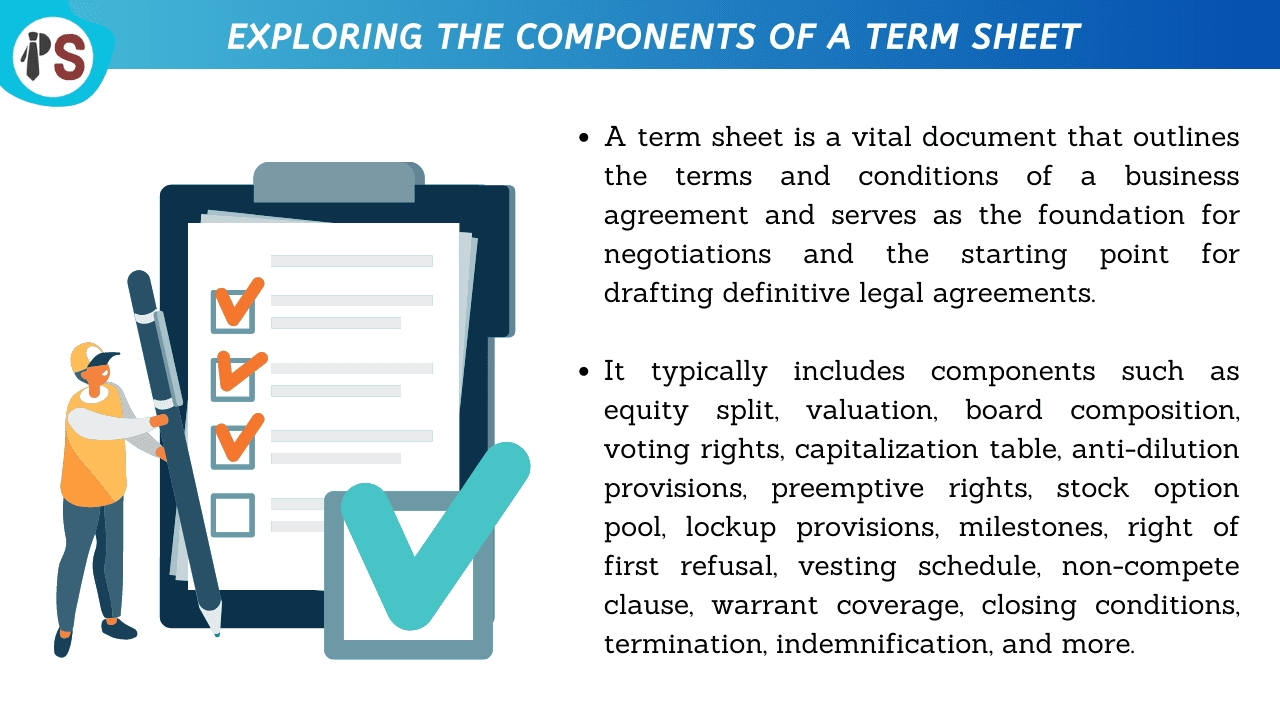
A term sheet is a crucial document that outlines the terms and conditions of a business agreement, typically for an investment or merger and acquisition transaction. It serves as the foundation for negotiations and the starting point for drafting definitive legal agreements. In this blog, we will discuss the various components that are typically included in a term sheet.
The term sheet begins with a description of the transaction, which outlines the nature of the deal, including the parties involved, the proposed investment or acquisition structure, and any other relevant details.
The equity split represents the ownership distribution between the existing shareholders and the new investors. This determines the percentage of the company that each party will own after the transaction is completed.
Valuation is a critical component of a term sheet, as it establishes the company's worth for the purpose of the transaction. This can be based on various factors such as revenue, profits, or market comparables.
The term sheet may specify the makeup of the company's board of directors, including the number of seats and representation from each party involved in the transaction.
Voting rights describe the rights and privileges of the shareholders in making decisions that affect the company. The term sheet may define any special voting rights granted to certain shareholders, such as the right to veto certain decisions.
A capitalization table, or cap table, is a summary of the company's equity ownership structure, including the number of shares held by each shareholder, their respective percentages of ownership, and any outstanding options or convertible securities.
Anti-dilution provisions protect investors from dilution of their ownership percentage in case of future equity issuances, such as fundraising rounds or stock option grants. These provisions typically come in the form of weighted average or full ratchet adjustments.
Preemptive rights give existing shareholders the right to purchase additional shares in future fundraising rounds, helping them maintain their ownership percentage.
A stock option pool is a reserve of company shares that are set aside for future grants to employees and other service providers. The term sheet may specify the size of the option pool and any conditions for its creation.
Lockup provisions restrict the sale of shares by certain shareholders for a specified period following the transaction, preventing them from flooding the market with shares and potentially driving down the share price.
Milestones are specific goals or achievements that the company is expected to reach as part of the agreement. These can include financial, operational, or strategic objectives and may be tied to funding tranches or other incentives.
The right of first refusal gives existing shareholders the opportunity to buy shares from other shareholders before they are offered to third parties, helping to maintain control over the company's ownership structure.
A vesting schedule outlines the timeline and conditions under which founders, employees, or other equity holders earn their ownership rights in the company.
A non-compete clause restricts the parties involved from engaging in competitive activities for a specified period and within a specified geographic area, protecting the company's competitive advantage.
Warrants are securities that grant the holder the right to purchase additional shares at a predetermined price. Warrant coverage outlines the terms and conditions of these warrants, including the exercise price and the expiration date.
Closing conditions are the prerequisites that must be met before the transaction can be completed, such as regulatory approvals, financing arrangements, or other conditions precedent.
Termination provisions outline the circumstances under which the term sheet can be terminated or the agreement can be called off. This could include a breach of terms, failure to meet certain conditions, or a specified expiration date.
Indemnification clauses provide protection to parties involved in the transaction from potential liabilities or losses arising from certain events or breaches of representations and warranties. These provisions allocate risk between the parties and may include caps, deductibles, or other limitations on the indemnifying party's liability.
A term sheet is a vital document that helps guide negotiations and sets the groundwork for a definitive agreement. By understanding the components of a term sheet, both investors and entrepreneurs can ensure they are well-prepared for negotiations and can protect their interests in the transaction. As with any legal document, it is essential to consult with an experienced attorney when drafting, reviewing, or negotiating a term sheet to ensure the terms accurately reflect the intentions of the parties involved and comply with applicable laws and regulations.
At Professional Saathi, we offer a range of business consultancy services that help businesses improve their performance, achieve growth, and overcome challenges.
Copyright 2026 © Created By KTPG PROFESSIONAL SAATHI CORPORATE CONSULTANT PRIVATE LIMITED, All Rights Reserved.
Leave Your Comment